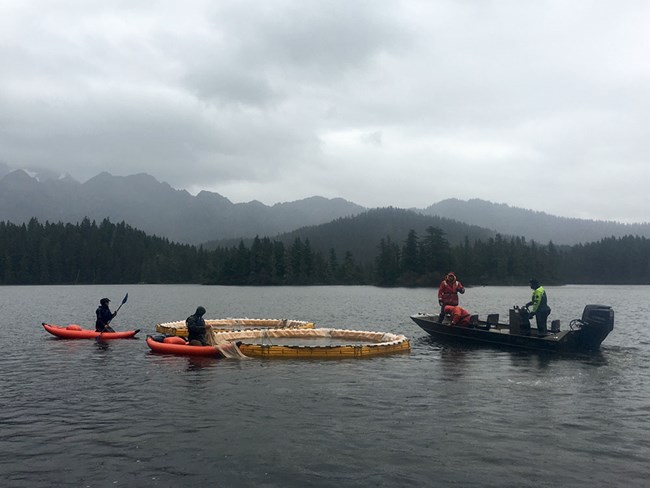Last updated: March 7, 2023
Article
How does Elodea impact juvenile salmon?

U.S. Geological Survey
Invasive species introductions to high-latitude ecosystems are accelerating due to warming climate, increasing travel, and changing land use. For example, the aquatic plant Elodea has the potential to be a widespread invader and is already established in 19 waterbodies in Alaska.
Elodea is known to alter freshwater habitats in several ways, yet little is known about its impact on fish that use those habitats. A primary concern is the effect of Elodea on juvenile Pacific salmon. Because this invading plant forms dense stands in shallow waters, it could impact important freshwater rearing habitats used by juvenile fish for hiding from predators and foraging for prey.
In this study, we used a field experiment to test the effect of Elodea on the growth of juvenile coho salmon (Oncorhynchus kisutch) in an infested lake near Cordova, Alaska. The study was led by the U.S. Geological Survey, with partners from the U.S. Forest Service and National Park Service. We found that juvenile coho reared in habitats dominated by Elodea had reduced growth and different diets than their counterparts in habitats dominated by native aquatic plants. While infested sites were not associated with decreased water quality or primary productivity compared to sites dominated by native vegetation, they did have lower zooplankton densities. We also found that Elodea height and vegetation richness increased macroinvertebrate densities. Combined, these results indicate that Elodea may alter the flow of energy to juvenile salmon by restructuring space and affecting prey resources for rearing fish. Furthermore, these results suggest that widespread establishment of Elodea may alter the quality of habitat for juvenile salmon and, by affecting juvenile fish growth, could lead to population-level impacts on salmon returns.
Elodea mediates juvenile salmon growth by altering physical structure in freshwater habitats
Abstract
Invasive species introductions in high latitudes are accelerating and elevating the need to address questions of their effects on Subarctic and Arctic ecosystems. As a driver of ecosystem function, submerged aquatic vegetation is one of the most deleterious biological invasions to aquatic food webs. The aquatic plant Elodea spp. has potential to be a widespread invader to Arctic and Subarctic ecosystems and is already established in 19 waterbodies in Alaska, USA. Elodea spp. has been found to alter ecosystem processes through multiple pathways; yet little is known about the impact of Elodea spp. on fish life history. A primary concern is the effect of Elodea spp. on juvenile Pacific salmon (Oncorhynchus spp.), because this invading plant can form dense stands in littoral zones, potentially impacting important freshwater rearing habitats used by juvenile fish for foraging and refuge from predators. We used a field experiment to test the effect of Elodea spp. on juvenile coho salmon (O. kisutch) growth in an infested lake near Cordova, Alaska, USA. We found that Elodea spp. stands result in reduced growth and a lower trophic position for juvenile coho salmon over the summer compared to habitats dominated by a native assemblage of aquatic plants. While infested sites were not associated with significant changes in water condition or primary productivity compared to sites dominated by native vegetation, zooplankton densities were reduced, and Elodea spp. height and vegetation richness increased macroinvertebrate densities. Combined, these results indicate that Elodea spp. may alter the flow of energy to juvenile salmon by restructuring space and affecting prey resources for rearing fish. Furthermore, these results suggest that widespread establishment of Elodea spp. may alter the quality of habitat for juvenile salmon and, by affecting juvenile fish growth, could lead to population-level impacts on salmon returns.
Carey, M. P., G. H. Reeves, S. A. Sethi, T. L. Tanner, D. B. Young, K. K. Bartz, and C. E. Zimmerman. 2023. Elodea mediates juvenile salmon growth by altering physical structure in freshwater habitats. Biological Invasions.
